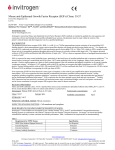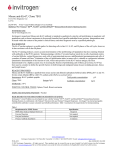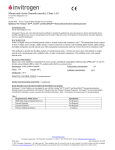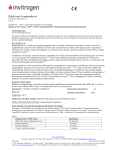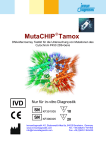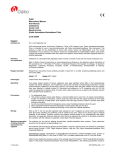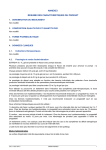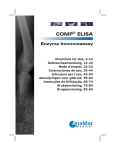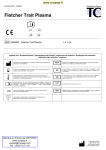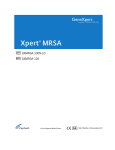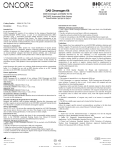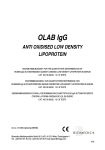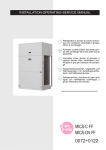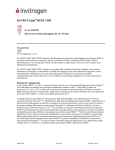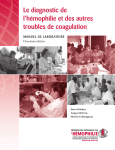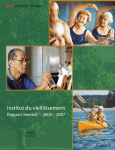Download Mouse anti-Estrogen Receptor, Clone 6F11
Transcript
Mouse anti-Estrogen Receptor, Clone 6F11 Lot No. [X] 08-4214 10 mL V-Line Predilute (Ready-to-Use) Antibody INTENDED USE Analyte Specific Reagent. Analytical and performance characteristics are not established. PRINCIPLE OF IMMUNOHISTOCHEMISTRY PROCEDURE This antibody may be used as the primary antibody in immunohistochemistry applications. In general, immunohistochemical (IHC) staining techniques allow for the visualization of antigens in frozen and paraffin-embedded tissues via the sequential application of a specific antibody to the antigen (primary antibody), a biotinylated antibody to the primary antibody (secondary antibody), an enzyme conjugate (tertiary component) and a chromogenic substrate with interposed washing steps. The enzymatic activation of the chromogen results in a visible reaction product at the antigen site. The specimen may then be counterstained and coverslipped. Results are interpreted using a light microscope. REAGENT PROVIDED This monoclonal antibody is derived from tissue culture supernatant, purified. The vial is filled to 10 mL with reagent containing PBS, 1% BSA, and 0.1% sodium azide. Immunogen: Recombinant full length alpha form of ER protein(3) Total protein concentration: g/L Clone: 6F11(4) Isotype: IgG1- kappa Antibody concentration: mg/L STORAGE: 2-8°C REQUIREMENTS FOR IMMUNOHISTOCHEMISTRY STAINING: Invitrogen’s V-Line Predilute was developed for use with the Ventana® ES™, NexES® and BenchMark™ Immunohistochemistry Staining Systems. Refer to the applicable Operator’s Manual for further information. ASSAY VALIDATION It is the laboratory’s responsibility to establish the analytical and performance characteristics of any diagnostic assay using this analyte specific reagent, and to validate the use of such assay. The following sources of information about assay validation and use are available: CAP Certification Program for Immunohistochemistry(5), the NCCLS IHC guideline(6), and the Clinical Laboratory Improvement Amendments of 1988.(7) Additional information about immunohistostaining can be found in references. (8-11) REFERENCES 1. Elias JM. Am J Clin Pathol 92:62-67 (1984). 2. Shi, ZR et al. J of Histochemistry and Cytochemistry 36(3):317-322 (1988). 3. Kumar, V et al. Cell 51:941-951 (1987). 4. Bevitt, DJ et al. J Pathol 183(2):228-232 (1997). 5. College of American Pathologists (CAP) Certification Program for Immunohistochemistry. CAP. Northfield, IL. Http://www.cap.org 6. O’Leary, T.J. et al. Quality assurance for immunocytochemistry; Proposed guideline. MM4-P. National Committee for Clinical Laboratory Standards (NCCLS). Wayne, PA. 1-46, 1997. 7. Clinical Laboratory Improvement Amendments of 1988: Final Rule, 57 FR 7163, February 28, 1992. 8. Elias, J.M. et al. Special Report: Quality Control in immunohistochemistry. Am J Clin Path 92:836, 1989. 9. Kiernan, J.A. Histological and Histochemical Methods: Theory and Practice. New York: Pergamon Press, 1981. 10. Sheehan, D.C. and Hrapchak, B.B. Theory and Practice of Histotechnology. St. Louis: C.V. Mosby Co., 1980. 11. Taylor and Cote. Immunomicroscopy: A Diagnostic Tool for the Surgical Pathologist. 2nd Ed. W.B. Saunders Co. Philadelphia, 1994. Authorized Representative for IVDD 98/79/EC: Invitrogen Ltd. Inchinnan Business Park 3 Fountain Drive Paisley PA4 9RF UK www.invitrogen.com Invitrogen Corporation • 542 Flynn Rd • Camarillo • CA 93012 • Tel: 800.955.6288 • E-mail: [email protected] PI 08-4214 (Rev 08/08) DCC-08-1089 © 2007 Invitrogen Corporation. All right reserved. These products may be covered by one or more Limited Use Label Licenses (see the Invitrogen Catalog or www.invitrogen.com). By use of these products you accept the terms and conditions of all applicable Limited Use Label Licenses. Anticuerpo Receptor de Estrógeno de ratón, Clon 6F11 Reactivo específico para electrolito [X] 08-4214 10 mL Anticuerpo prediluido V-Line (listo para usar) Optimizado para los sistemas de tinción inmunohistoquímica Ventana® ES™, NexES® y BenchMark™ PROPÓSITO DE USO Reactivo específico para electrolito Las características analíticas y de rendimiento no han sido determinadas. PRINCIPIO DEL PROCEDIMIENTO DE INMUNOHISTOQUÍMICA Este anticuerpo puede ser utilizado como el anticuerpo primario con el método de detección marcado con estreptavidinabiotina (LAB-SA)(1,2) o un método equivalente. En general, las técnicas de tinción inmunohistoquímicas (IHQ) permiten la visualización de antígenos en cortes de tejido congelados y infiltrados en parafina a través de la aplicación secuencial de un anticuerpo específico al antígeno (anticuerpo primario), un anticuerpo biotinilado al anticuerpo primario (anticuerpo secundario), un conjugado enzimático (componente terciario) y un sustrato cromogénico con pasos intermedios de lavado. La activación enzimática del cromógeno resulta en un producto de reacción visible en el sitio del antígeno. La muestra puede ser contra coloreada y cubierta con un cubreobjeto. Los resultados se interpretan con un microscopio de luz. REACTIVO SUMINISTRADO El anticuerpo Receptor de la Progesterona de ratón se deriva del sobrenadante del cultivo tisular y se diluye en tampón fosfato (PBS), Ph 7,4, y seroalbúmina bovina al 1% (BSA) con azida de sodio al 0,1% (NaN3) como conservante. Inmunogén: Proteína recombinante completa que corresponde a la forma alfa del receptor de ER(3) Isotipo: IgG1-kappa Clon: 6F11(4) ALMACENAMIENTO: 2-8°C REQUISITOS PARA LA TINCIÓN INMUNOHISTOQUÍMICA: El prediluido V-Line de Invitrogen fue creado para usarse con los sistemas de tinción inmunohistoquímica Ventana® ES™, NexES® y BenchMark™. VALIDACIÓN DEL ANÁLISIS El laboratorio es responsable por la determinación de las características analíticas y de rendimiento de cualquier análisis diagnóstico mediante este reactivo específico para electrolitos y por la validación del uso de dicho análisis. Se dispone de las siguientes fuentes de información sobre la validación y uso del análisis: Programa de certificación CAP para inmunohistoquímica(5), las recomendaciones sobre IHQ del NCCLS(6), y las modificaciones para mejoría del laboratorio clínico 1988.(7) En las referencias puede encontrarse información adicional sobre inmunotinción histológica.(8-11) www.invitrogen.com Invitrogen Corporation • 542 Flynn Rd • Camarillo • CA 93012 • Tel: 800.955.6288 • E-mail: [email protected] PI 08-4214 (Rev 08/08) DCC-08-1089 © 2007 Invitrogen Corporation. All right reserved. These products may be covered by one or more Limited Use Label Licenses (see the Invitrogen Catalog or www.invitrogen.com). By use of these products you accept the terms and conditions of all applicable Limited Use Label Licenses. CARGA DEL DISPENSADOR DEFINIDO POR EL USUARIO Invitrogen recomienda el siguiente procedimiento ® para llenar los dispensadores de reactivo Ventana® con el prediluido V-Line de Invitrogen. Consulte el Manual del Usuario de Ventana® para obtener más información. 1. Retire el tapón del extremo de la Jeringa de transferencia Ventana®, luego retire el émbolo por completo del cilindro y vuelva a colocar el tapón en el cilindro de la jeringa. 2. Coloque una etiqueta a la Jeringa de reactivo y transferencia Ventana® indicando el anticuerpo Invitrogen® utilizado. 3. Vierta la ampolla que se adjunta de prediluido V-Line (10 mL, anticuerpo listo para usar) en el cilindro de la Jeringa de transferencia Ventana®, luego vuelva a colocar el émbolo en el cilindro. 4. Invierta la Jeringa de transferencia Ventana® colocando el tapón hacia arriba y el émbolo hacia abajo. Luego retire el tapón. 5. Haga salir el aire de la Jeringa de transferencia Ventana® empujando cuidadosamente el émbolo hacia el tapón. 6. Ahora, retire el tapón de la punta de la Jeringa de reactivo Ventana®. 7. Conecte la boquilla de la Jeringa de reactivo Ventana® a la boquilla de la Jeringa de transferencia Ventana®. 8. Dispense anticuerpo de la Jeringa de transferencia Ventana® hacia la Jeringa de reactivo Ventana®. La cantidad máxima que puede contener la Jeringa de reactivo Ventana® es 12,5 mL; lo cual es suficiente para unas 120 pruebas. 9. Coloque la etiqueta Invitrogen adjunta® en la Jeringa de reactivo Ventana®. El anticuerpo prediluido V-Line de Invitrogen está listo para usar con los sistemas de tinción inmunohistoquímica Ventana® ES™, NexES® y BenchMark™. Para obtener detalles específicos sobre el funcionamiento y la secuencia de procedimientos de los sistemas de tinción inmunohistoquímica Ventana® ES™, NexES® y BenchMark™ consulte los manuales del usuario correspondientes y respectivos®. 1. 2. 3. 4. 5. 6. 7. 8. 9. 10. 11. Elias JM. Am J Clin Pathol 92:62-67 (1984). Shi, ZR et al. J of Histochemistry and Cytochemistry 36(3):317-322 (1988). Kumar, V et al. Cell 51:941-951 (1987). Bevitt, DJ et al. J Pathol 183(2):228-232 (1997). College of American Pathologists (CAP) Certification Program for Immunohistochemistry. CAP. Northfield, IL. Http://www.cap.org O’Leary, T.J. et al. Quality assurance for immunocytochemistry; Proposed guideline. MM4-P. National Committee for Clinical Laboratory Standards (NCCLS). Wayne, PA. 1-46, 1997. Clinical Laboratory Improvement Amendments of 1988: Final Rule, 57 FR 7163, February 28, 1992. Elias, J.M. et al. Special Report: Quality Control in immunohistochemistry. Am J Clin Path 92:836, 1989. Kiernan, J.A. Histological and Histochemical Methods: Theory and Practice. New York: Pergamon Press, 1981. Sheehan, D.C. and Hrapchak, B.B. Theory and Practice of Histotechnology. St. Louis: C.V. Mosby Co., 1980. Taylor and Cote. Immunomicroscopy: A Diagnostic Tool for the Surgical Pathologist. 2nd Ed. W.B. Saunders Co. Philadelphia, 1994. MARCAS COMERCIALES Cap-Plus™, Clearmount™, Digest-All™, HistoGrip™, Histomount™, y Histostain®, NBA™, PicTure™ y Zymed® son marcas comerciales de Zymed Laboratories, Inc. Ventana® ES™, NexES® y BenchMark™ son marcas comerciales de Ventana® Medical Systems, Inc. Los anticuerpos V-Line son elaborados exclusivamente por Zymed® Laboratories, Inc. y no implican ni la aprobación ni el aval de Ventana® Medical Systems, Inc. Las empresas Zymed® y Ventana® no están afiliadas, asociadas ni relacionadas de manera alguna. Para obtener más información vea la versión inglesa de la ficha técnica o vaya a www.invitrogen.com. TIENE ALGUNA PREGUNTA SOBRE ESTE PRODUCTO, DIRÍJASE A SU DISTRIBUIDOR LOCAL. Representante autorizado de IVDD 98/79/EC: Invitrogen Ltd. Inchinnan Business Park 3 Fountain Drive Paisley PA4 9RF UK www.invitrogen.com Invitrogen Corporation • 542 Flynn Rd • Camarillo • CA 93012 • Tel: 800.955.6288 • E-mail: [email protected] PI 08-4214 (Rev 08/08) DCC-08-1089 © 2007 Invitrogen Corporation. All right reserved. These products may be covered by one or more Limited Use Label Licenses (see the Invitrogen Catalog or www.invitrogen.com). By use of these products you accept the terms and conditions of all applicable Limited Use Label Licenses. Souris anti-Recepteur D’Estrogenes, Clone 6F11 Réactif spécifique à l’analyte. [X] 08-4214 10 mL Anticorps de prédilution V-Line (prêt à l’emploi) Optimisé pour les systèmes de coloration immunohistochimique Ventana® ES™, NexES® et BenchMark™ UTILISATION VOULUE Réactif spécifique à l’analyte. Les caractéristiques analytiques et de performance ne sont pas établies. PRINCIPE DE LA PROCÉDURE D’IMMUNOHISTOCHIMIE Cet anticorps peut être utilisé comme anticorps primaire avec la méthode de détection étiquetée streptavidine-biotine (LAB-SA)(1,2) ou une méthode équivalente. En général, les techniques de coloration immunohistochimiques (IHC) permettent de visualiser des antigènes dans des tissus congelés et incorporés dans de la paraffine par l’intermédiaire de l’application séquentielle d’un anticorps spécifique à l’antigène (anticorps primaire), un anticorps biotinylé à l’anticorps primaire (anticorps secondaire), un conjugué enzymatique (composant tertiaire) et un substrat chromogénique avec des étapes de lavage interposées. L’activation enzymatique du chromogène produit une réaction visible du produit au site de l’antigène. Le spécimen peut alors être contre-coloré et recouvert d’une lamelle couvre-objet. Les résultats sont interprétés à l’aide d’un microscope optique. REACTIF FOURNI Souris anti-Recepteur de Progesterone est dérivé d’un surnageant d’une culture de tissu et dilué dans du Phosphate Tamponné Salin (PBS), pH 7.4, et 1% d'albumine de sérum de bovin (BSA) avec 0.1% azide de sodium(NaN3) comme préservatif. Immunogène: Protéine recombinante pleine longueur correspondant à la forme alpha de récepteur d’estrogène humain(3) Isotype: IgG1-kappa Clone: 6F11(4) STOCKAGE : à 2-8°C MATÉRIEL NÉCESSAIRE POUR LA COLORATION IMMUNOHISTOCHIMIQUE : La prédilution V-Line de Invitrogen a été conçue pour être utilisée avec les systèmes de coloration immunohistochimique Ventana® ES™, NexES® et BenchMark™. VALIDATION DE L’ESSAI Il incombe au laboratoire d’établir les caractéristiques analytiques et de performance de tout essai de diagnostic utilisant ce réactif spécifique à l’analyte, et de valider l’utilisation de cet essai. Les sources d’information suivantes concernant la validation et l’utilisation de l’essai sont disponibles : programme de certification CAP pour l’immunohistochimie(5), la directive concernant l’IHC de NCCLS(6), et les modifications d’amélioration du laboratoire clinique de 1988.(7) Vous trouverez des données supplémentaires concernant l’immunohistocoloration dans les références.(8-11) www.invitrogen.com Invitrogen Corporation • 542 Flynn Rd • Camarillo • CA 93012 • Tel: 800.955.6288 • E-mail: [email protected] PI 08-4214 (Rev 08/08) DCC-08-1089 © 2007 Invitrogen Corporation. All right reserved. These products may be covered by one or more Limited Use Label Licenses (see the Invitrogen Catalog or www.invitrogen.com). By use of these products you accept the terms and conditions of all applicable Limited Use Label Licenses. CHARGEMENT DU DISTRIBUTEUR TEL QUE DÉFINI PAR L’UTILISATEUR Invitrogen® recommande l’utilisation de la procédure ci-après pour remplir les distributeurs de réactif Ventana® avec la prédilution VLine de Invitrogen. Se reporter au manuel de l’utilisateur de Ventana® pour des détails supplémentaires. 1. Retirer le bouchon à l’extrémité de la seringue de transfert Ventana®, retirer ensuite complètement le piston du corps de pompe et remettre le bouchon dans le corps de pompe de la seringue. 2. Marquer de façon approprié le réactif Ventana® et la seringue de transfert avec l’anticorps de Invitrogen® utilisé. 3. Verser le flacon de prédilution V-Line inclus (10 mL, anticorps prêt à l’emploi) dans le corps de pompe de la seringue de transfert de Ventana®, ensuite remettre le piston dans le corps de pompe. 4. Retourner la seringue de transfert de Ventana® le bouchon tourné vers le haut et le piston vers le bas. Retirer ensuite le bouchon. 5. Chasser l’air de la seringue de transfert Ventana® en poussant doucement le piston vers le bouchon. 6. Retirer ensuite le bouchon de l’extrémité de la seringue de réactif Ventana®. 7. Attacher l’embout de la seringue de réactif Ventana® sur l’embout de la seringue de transfert Ventana®. 8. Faire passer l’anticorps de la seringue de transfert Ventana® dans la seringue de réactif Ventana®. La quantité maximale contenue dans la seringue de réactif Ventana® est de 12,5 mL ce qui permet d’effectuer environ 120 tests. 9. Poser l’étiquette de Invitrogen® ci-jointe sur la seringue de réactif de Ventana®. L’anticorps de prédilution V-Line de Invitrogen est prêt à être utilisé avec les systèmes de coloration immunohistochimique de Ventana® ES™, NexES® et BenchMark™. Pour des détails spécifiques concernant le fonctionnement et la séquence des événements des systèmes de coloration immunohistochimique de Ventana® ES™, NexES® et BenchMark™, se reporter au manuel de l’utilisateur Ventana® en question. 1. 2. 3. 4. 5. 6. 7. 8. 9. 10. 11. Elias JM. Am J Clin Pathol 92:62-67 (1984). Shi, ZR et al. J of Histochemistry and Cytochemistry 36(3):317-322 (1988). Kumar, V et al. Cell 51:941-951 (1987). Bevitt, DJ et al. J Pathol 183(2):228-232 (1997). College of American Pathologists (CAP) Certification Program for Immunohistochemistry. CAP. Northfield, IL. Http://www.cap.org O’Leary, T.J. et al. Quality assurance for immunocytochemistry; Proposed guideline. MM4-P. National Committee for Clinical Laboratory Standards (NCCLS). Wayne, PA. 1-46, 1997. Clinical Laboratory Improvement Amendments of 1988: Final Rule, 57 FR 7163, February 28, 1992. Elias, J.M. et al. Special Report: Quality Control in immunohistochemistry. Am J Clin Path 92:836, 1989. Kiernan, J.A. Histological and Histochemical Methods: Theory and Practice. New York: Pergamon Press, 1981. Sheehan, D.C. and Hrapchak, B.B. Theory and Practice of Histotechnology. St. Louis: C.V. Mosby Co., 1980. Taylor and Cote. Immunomicroscopy: A Diagnostic Tool for the Surgical Pathologist. 2nd Ed. W.B. Saunders Co. Philadelphia, 1994. MARQUE DE FABRIQUE Cap-Plus™, Clearmount™, Digest-All™, HistoGrip™, Histomount™, et Histostain®, NBA™, PicTure™, et Zymed® sont des marques des Zymed Laboratories, Inc. Ventana® ES™, NexES® et BenchMark™ sont des marques déposées de Ventana® Medical Systems, Inc. Les anticorps V-Line sont développés exclusivement par Zymed® Laboratories, Inc. et n’insinuent pas une approbation ou un soutien de la part de Ventana® Medical Systems, Inc. Zymed® et Ventana® ne sont en aucune façon affiliées ou associées. Pour des informations plus détaillées, veuillez vous référer aux feuilles de données en version anglaise ou aller sur www.invitrogen.com. SI VOUS AVEZ DES QUESTIONS SUR CE PRODUIT CONTACTEZ VOTRE DISTRIBUTEUR LOCAL. Représentant Autorisé pour IVDD 98/79/EC: Invitrogen Ltd. Inchinnan Business Park 3 Fountain Drive Paisley PA4 9RF UK www.invitrogen.com Invitrogen Corporation • 542 Flynn Rd • Camarillo • CA 93012 • Tel: 800.955.6288 • E-mail: [email protected] PI 08-4214 (Rev 08/08) DCC-08-1089 © 2007 Invitrogen Corporation. All right reserved. These products may be covered by one or more Limited Use Label Licenses (see the Invitrogen Catalog or www.invitrogen.com). By use of these products you accept the terms and conditions of all applicable Limited Use Label Licenses. Topo anti- Recettore Degli Estrogeni, Clone 6F11 Reagente analita-specifico [X] 08-4214 10 mL Anticorpo prediluito V-Line (Pronto per l’uso) Ottimizzato per i sistemi di colorazione immunoistochimica Ventana®ES™, NexES® e BenchMark™ SCOPI D’UTILIZZO Reagente analita-specifico. Le caratteristiche analitiche e della performance non sono state stabilite. PRINCIPIO DI FUNZIONAMENTO DELLA PROCEDURA IMMUNOISTOCHIMICA Questo anticorpo può essere usato quale anticorpo primario nel metodo di rilevazione marcato con streptavidina-biotina (LAB-SA)(1,2) o metodi analoghi. In termini generali, le tecniche di colorazione immunoistochimica (IIC) consentono la visualizzazione di antigeni in tessuti congelati ed inclusi in paraffina tramite l’applicazione sequenziale di un anticorpo specifico sull’antigene (anticorpo primario), di un anticorpo biotilinato sull’anticorpo primario (anticorpo secondario), un coniugato enzimatico (componente terziario) ed un substrato cromogenico con fasi di lavaggio frapposte. L’attivazione enzimatica del cromogeno induce un prodotto di reazione visibile presso il sito dell’antigene. Il provino può quindi essere controcolorato ed inserito in un coprivetrino. I risultati possono essere interpretati usando un microscopio ottico.. REAGENTI FORNITI Topo anti-Recettore Progesterone è derivato da supernatante di coltura di tessuto e diluito in soluzione salina tamponata al fosfato (PBS), pH 7,4, e 1% di albumina di siero bovino (BSA) con 0,1% sodio azide (NaN3) come conservante. Immunogeno: Proteina ricombinante di lunghezza completa corrispondente alla forma alfa del ricettore dell'estrogeno umano(3) Isotipo: IgG1-kappa Clone: 6F11(4) CONSERVAZIONE: 2-8 °C REQUISITI PER LA COLORAZIONE IMMUNOISTOCHIMICA: L’Anticorpo diluito V-Line di Invitrogen è stato sviluppato per l’uso con i sistemi di colorazione immunoistochimica Ventana® ES™, NexES® e BenchMark™. CONVALIDA DELLE PROVE Ciascun singolo laboratorio dovrà determinare le caratteristiche analitiche e della performance delle prove diagnostiche eseguite utilizzando il presente reagente analita-specifico e quindi convalidare l’uso di dette prove. Sono disponibili le seguenti fonti di informazioni sulla convalida delle prove ed il relativo utilizzo: Programma di certificazione per l’immunoistochimica CAP(5), Linea guida sull’IIC del NCCLS(6) e Emendamenti di perfezionamento delle procedure cliniche di laboratorio del 1988.(7) Nel materiale di consultazione sono rinvenibili ulteriori informazioni sulla colorazione immunoistochimica.(8-11) www.invitrogen.com Invitrogen Corporation • 542 Flynn Rd • Camarillo • CA 93012 • Tel: 800.955.6288 • E-mail: [email protected] PI 08-4214 (Rev 08/08) DCC-08-1089 © 2007 Invitrogen Corporation. All right reserved. These products may be covered by one or more Limited Use Label Licenses (see the Invitrogen Catalog or www.invitrogen.com). By use of these products you accept the terms and conditions of all applicable Limited Use Label Licenses. CARICAMENTO DELL’EROGATORE DEFINITO DALL’UTENTE Invitrogen® raccomanda di osservare la seguente procedura per il riempimento degli erogatori di reagente Ventana® con l’anticorpo prediluito V-Line di Invitrogen. Per ulteriori chiarimenti, si prega di consultare il Manuale per l’utente Ventana®. 1. Rimuovere il tappo posto sull’estremità della siringa di trasferimento Ventana®, quindi estrarre completamente lo stantuffodal cilindro e rimettere il tappo sul cilindro della siringa. 2. Etichettare debitamente la siringa per reagenti e la siringa di trasferimento Ventana® specificando il nome dell’anticorpo Invitrogen® utilizzato. 3. Versare il contenuto della boccetta acclusa di anticorpo prediluito V-Line di Invitrogen (10 mL, anticorpo pronto per l’uso) nel cilindro della siringa di trasferimento Ventana®, quindi reinserire lo stantuffo nel cilindro. 4. Capovolgere la siringa di trasferimento Ventana® in modo che il tappo sia rivolto verso l’alto e lo stantuffo verso il basso. Quindi rimuovere il tappo. 5. Eliminare l’aria dalla siringa di trasferimento Ventana® spingendo cautamente lo stantuffo verso il tappo. 6. A questo punto, rimuovere il tappo dalla punta della siringa di trasferimento Ventana®. 7. Collegare l’ugello della siringa per reagenti Ventana® all’ugello della siringa di trasferimento Ventana®. 8. Erogare l’anticorpo dalla siringa di trasferimento Ventana® alla siringa per reagenti Ventana®. La siringa per reagenti Ventana® ha una capacità massima di 12,5 mL; ovvero un quantitativo sufficiente per eseguire 120 prove circa. 9. Attaccare l’etichetta acclusa Invitrogen® sulla siringa per reagenti Ventana®. L’anticorpo prediluito V-Line di Invitrogen è fornito pronto per l’uso ed è da utilizzarsi con i sistemi di colorazione immunoistochimica Ventana® ES™, NexES® e BenchMark™. Per informazioni particolareggiate sul funzionamento e la sequenza procedurale dei sistemi di colorazione immunoistochimica Ventana® ES™, NexES® e BenchMark™, si prega di consultare i rispettivi Manuali per l’utente Ventana®. 1. 2. 3. 4. 5. 6. 7. 8. 9. 10. Elias JM. Am J Clin Pathol 92:62-67 (1984). Shi, ZR et al. J of Histochemistry and Cytochemistry 36(3):317-322 (1988). Kumar, V et al. Cell 51:941-951 (1987). Bevitt, DJ et al. J Pathol 183(2):228-232 (1997). College of American Pathologists (CAP) Certification Program for Immunohistochemistry. CAP. Northfield, IL. Http://www.cap.org O’Leary, T.J. et al. Quality assurance for immunocytochemistry; Proposed guideline. MM4-P. National Committee for Clinical Laboratory Standards (NCCLS). Wayne, PA. 1-46, 1997. Clinical Laboratory Improvement Amendments of 1988: Final Rule, 57 FR 7163, February 28, 1992. Elias, J.M. et al. Special Report: Quality Control in immunohistochemistry. Am J Clin Path 92:836, 1989. Kiernan, J.A. Histological and Histochemical Methods: Theory and Practice. New York: Pergamon Press, 1981. Sheehan, D.C. and Hrapchak, B.B. Theory and Practice of Histotechnology. St. Louis: C.V. Mosby Co., 1980. 11. Taylor and Cote. Immunomicroscopy: A Diagnostic Tool for the Surgical Pathologist. 2nd Ed. W.B. Saunders Co. Philadelphia, 1994. MARCHI REGISTRATI Cap-Plus™, Clearmount™, Digest-All™, HistoGrip™, Histomount™, e Histostain®, NBA™, PicTure™, e Zymed® sono marchi registrati di Zymed Laboratories, Inc. Ventana® ES™, NexES® e BenchMark™ sono marchi commerciali di proprietà di Ventana® Medical Systems, Inc. Gli anticorpi V-Line sono sviluppati esclusivamente da Zymed® Laboratories, Inc. e non implicano alcuna autorizzazione o approvazione da parte di Ventana® Medical Systems, Inc. Zymed® e Ventana®non sono imprese consociate, affiliate o collegate in alcun altro modo. Per informazioni più dettagliate vi preghiamo di consultare la versione inglese del catalogo oppure visitate il sito www.invitrogen.com. SE AVETE DOMANDE SUL PRODOTTO, CONTATTATE IL VOSTRO DISTRIBUTORE PIÙ`VICINO. Rappresentante Autorizzato per IVDD 98/79/EC: Invitrogen Ltd. Inchinnan Business Park 3 Fountain Drive Paisley PA4 9RF UK www.invitrogen.com Invitrogen Corporation • 542 Flynn Rd • Camarillo • CA 93012 • Tel: 800.955.6288 • E-mail: [email protected] PI 08-4214 (Rev 08/08) DCC-08-1089 © 2007 Invitrogen Corporation. All right reserved. These products may be covered by one or more Limited Use Label Licenses (see the Invitrogen Catalog or www.invitrogen.com). By use of these products you accept the terms and conditions of all applicable Limited Use Label Licenses. Maus Anti-Estrogen Rezeptor, Klon 6F11 Analytspezifisches Reagenz [X] 08-4214 10 mL V-Line Vorverdünnung - (gebrauchsfertiger) Antikörper Optimiert für die immunhistochemischen Färbungssysteme Ventana® ES™, NexES® und BenchMark™ BEABSICHTIGTER NUTZEN Analytspezifisches Reagenz. Analytische und Leistungsmerkmale wurden nicht festgelegt. IMMUNHISTOCHEMISCHES VERFAHRENSPRINZIP Dieser Antikörper kann als primärer Antikörper mit der gekennzeichneten Streptavidin-Biotin (LAB-SA)(1,2) Detektion oder einer gleichwertigen Methode verwendet werden. Generell ermöglichen immunhistochemische (IHC) Färbungsmethoden die Visualisierung der Antigene in gefrorenem und in Paraffin eingebetteten Geweben durch die sequenzielle Anwendung eines spezifischen Antikörpers gegen das Antigen (primärer Antikörper), eines biotinylierten Antikörpers gegen den primären Antikörper (sekundären Antikörper), eines Enzymkonjugats (tertiäre Komponente) und eines chromogenen Substrats mit zwischengeschalteten Waschschritten. Die enzymatische Aktivierung des Chromogens führt zu einer sichtbaren Reaktion an der Antigenstelle. Die Probe kann anschließend gegengefärbt und mit einem Coverslip versehen werden. Die Ergebnisse werden unter Verwendung eines Lichtmikroskops interpretiert. REAGENS GELIEFERT Maus Anti-Progesterone Rezeptor ist wird aus Gewebekultur-Supernatant abgeleitet und verdünnt in Phosphatgepufferter Salzlösung (PBS), pH 7.4, und 1%igem Rinder Serum Albumin (BSA) mit 0.1% Sodium Azid (NaN3) als ein Konservierungsmittel. Immunogen: Rekombinantes Protein mit voller Länge, entspricht der Alpha-Form des humanen Östrogenrezeptors(3) Isotyp: IgG1-kappa Klon: 6F11(4) LAGERUNG: 2-8°C VORAUSSETZUNGEN FÜR DIE IMMUNHISTOCHEMISCHE FÄRBUNG: Invitrogens V-Line Vorverdünnung wurde speziell für die Verwendung mit den immunhistochemischen Färbungssystemen Ventana® ES™, NexES® und BenchMark™. ASSAY-VALIDIERUNG Das Labor ist dafür verantwortlich, die analytischen und Leistungsmerkmale jedes Diagnose-Assays unter Verwendung dieses analytspezifischen Reagenz zu bestimmen und die Verwendung des Assay zu validieren. Folgende Informationsquellen über die Validierung und Verwendung des Assay stehen zur Verfügung: CAP-Zertifizierungsprogramm für Immunhistochemie(5), die NCCLS IHC Richtlinie(6) und die Clinical Laboratory Improvement Amendments von 1988.(7) Weitere Informationen über Immunhistochemische Färbung sind dem entsprechenden Referenzmaterial zu entnehmen.(8-11) www.invitrogen.com Invitrogen Corporation • 542 Flynn Rd • Camarillo • CA 93012 • Tel: 800.955.6288 • E-mail: [email protected] PI 08-4214 (Rev 08/08) DCC-08-1089 © 2007 Invitrogen Corporation. All right reserved. These products may be covered by one or more Limited Use Label Licenses (see the Invitrogen Catalog or www.invitrogen.com). By use of these products you accept the terms and conditions of all applicable Limited Use Label Licenses. FÜLLEN DES VOM BENUTZER DEFINIERTEN DISPENSERS Invitrogen empfiehlt die folgende Methode ®zum Füllen der Ventana® Reagenz-Dispenser mit Invitrogen V-Line Vorverdünnung. Weitere Anweisungen sind dem Ventana® Benutzerhandbuch zu entnehmen. 1. Den Verschluss am Ende der Ventana® Transferspritze entfernen, dann den Kolben ganz aus dem Zylinder herausziehen und den Verschluss wieder auf dem Spritzenzylinder anbringen. 2. Die Ventana® Reagenz- und Transferspritze entsprechend mit dem verwendeten Invitrogen® Antikörper kennzeichnen. 3. Das beiliegende Fläschchen mit V-Line Vorverdünnung (10 mL gebrauchsfertiger Antikörper) in den Zylinder der Ventana® Transferspritze geben und dann den Kolben wieder in den Zylinder schieben. 4. Die Ventana® Transferspritze invertieren. Dazu den Verschluss nach oben und den Kolben nach unten richten. Dann den Verschluss entfernen. 5. Zum Entlüften der Ventana® Transferspritze den Kolben vorsichtig in Richtung Verschluss schieben. 6. Dann den Verschluss von der Spitze der Ventana® Reagenzspritze abnehmen. 7. Die Ventana® Reagenzspritzendüse an der Ventana® Transferspritzendüse befestigen. 8. Antikörper aus der Ventana® Transferspritze in die Ventana® Reagenzspritze spritzen. Das maximale Fassungsvermögen der Ventana® Reagenzspritze beträgt 12,5 mL und reicht für etwa 120 Tests. 9. Das beiliegende Invitrogen® Etikett auf der Ventana® Reagenzspritze anbringen. Der Invitrogen V-Line Vorverdünnungs-Antikörper kann jetzt mit den immunhistochemischen Färbungssystemen Ventana® ES™, NexES® und BenchMark™ eingesetzt werden. Spezifische Details zum Betrieb und zur Ereignissequenz der immunhistochemischen Färbungssysteme Ventana® ES™, NexES® und BenchMark™ sind den entsprechenden Ventana® Benutzerhandbüchern zu entnehmen. 1. 2. 3. 4. 5. 6. 7. 8. 9. 10. 11. Elias JM. Am J Clin Pathol 92:62-67 (1984). Shi, ZR et al. J of Histochemistry and Cytochemistry 36(3):317-322 (1988). Kumar, V et al. Cell 51:941-951 (1987). Bevitt, DJ et al. J Pathol 183(2):228-232 (1997). College of American Pathologists (CAP) Certification Program for Immunohistochemistry. CAP. Northfield, IL. Http://www.cap.org O’Leary, T.J. et al. Quality assurance for immunocytochemistry; Proposed guideline. MM4-P. National Committee for Clinical Laboratory Standards (NCCLS). Wayne, PA. 1-46, 1997. Clinical Laboratory Improvement Amendments of 1988: Final Rule, 57 FR 7163, February 28, 1992. Elias, J.M. et al. Special Report: Quality Control in immunohistochemistry. Am J Clin Path 92:836, 1989. Kiernan, J.A. Histological and Histochemical Methods: Theory and Practice. New York: Pergamon Press, 1981. Sheehan, D.C. and Hrapchak, B.B. Theory and Practice of Histotechnology. St. Louis: C.V. Mosby Co., 1980. Taylor and Cote. Immunomicroscopy: A Diagnostic Tool for the Surgical Pathologist. 2nd Ed. W.B. Saunders Co. Philadelphia, 1994. WARENZEICHEN Cap-Plus™, Clearmount™, Digest-All™, HistoGrip™, Histomount™, und Histostain®, NBA™, PicTure™, und Zymed® sind Warenzeichen der Zymed Laboratories, Inc. Ventana® ES™, NexES® und BenchMark™ sind Marken der Ventana® Medical Systems, Inc. V-Line Antikörper werden ausschließlich von Zymed® Laboratories, Inc. entwickelt und wurden nicht durch Ventana® Medical Systems, Inc. genehmigt oder gefördert. Zymed® und Ventana® sind in keiner Weise angegliedert, aneinander angeschlossen bzw. miteinander verbunden. Für genauere Information beziehen Sie sich bitte entweder auf die englische Version auf der Datenplatte oder auf www.invitrogen.com. SOLLTEN SIE IRGENDWELCHE FRAGEN ÜBER DIESES PRODUKT HABEN, WENDEN SIE SICH BITTE AN IHREN ÖRTLICHEN VERTEILER. Bevollmächtigter Repräsentant für IVDD 98/79/EC: Invitrogen Ltd. Inchinnan Business Park 3 Fountain Drive Paisley PA4 9RF UK www.invitrogen.com Invitrogen Corporation • 542 Flynn Rd • Camarillo • CA 93012 • Tel: 800.955.6288 • E-mail: [email protected] PI 08-4214 (Rev 08/08) DCC-08-1089 © 2007 Invitrogen Corporation. All right reserved. These products may be covered by one or more Limited Use Label Licenses (see the Invitrogen Catalog or www.invitrogen.com). By use of these products you accept the terms and conditions of all applicable Limited Use Label Licenses.









